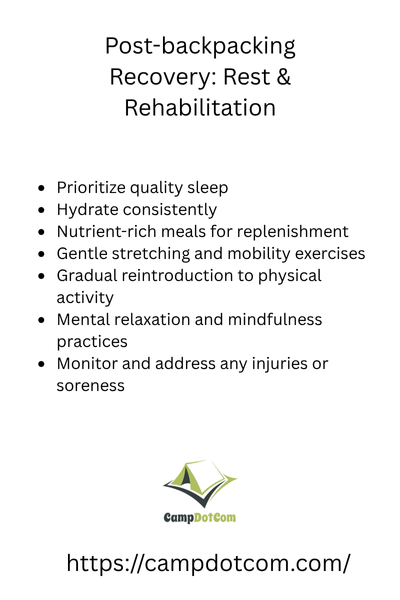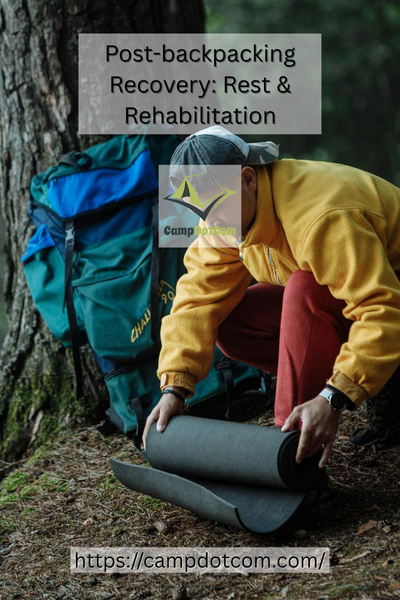You did it! You tackled the trail, conquered those peaks, and maybe even survived on nothing but granola bars and sheer determination. But now that you’re back home, reality hits—your legs feel like jelly, your back protests every movement, and you’re wondering why you ever thought 20 miles in a day was a good idea. Welcome to post-backpacking recovery.
Let’s talk about how to get you back on your feet (literally) and ready for your next adventure.
Read More About Post-Backpacking Recovery

First Things First: Rest Is Your Best Friend
After days (or weeks) of pushing your body, you need to give it a break. Think of it like rebooting a glitchy computer. Sometimes, you just have to turn it off and let it rest. And no, rest does not mean scrolling through Instagram while pretending to stretch. It means actual, deep rest. Sleep in. Lounge around. If your body says, “Hey, let us just exist for a bit,” listen to it.
As an Amazon Associate, I earn from qualifying purchases. Some of the links in this article are affiliate links. This means that, at zero cost to you, I will earn an affiliate commission if you click through the link and finalize a purchase.
When I got back from my first multi day trek, I ignored this rule. The result? A limp that lasted a week and a newfound respect for my own limits. Trust me, your body will thank you if you take recovery seriously.
Hydration: More Than Just Chugging Water
You probably drank a lot on the trail (or at least, you should have). But dehydration doesn’t magically fix itself once you’re home. Your muscles are screaming for proper hydration, and plain water might not be enough. Electrolytes are key, so mix in some coconut water, sports drinks, or a pinch of salt and lemon in your water. Bonus: it tastes better, too.
More Things to Know About Post-Backpacking Recovery

Food: Rebuild, Don’t Just Refuel
Here’s the fun part—eating. After burning thousands of calories per day, your body needs serious nutrition to repair itself. Load up on:
- Protein (helps rebuild those tired muscles—think eggs, chicken, tofu, or lentils)
- Healthy fats (avocado, nuts, olive oil—great for reducing inflammation)
- Complex carbs (sweet potatoes, whole grains—because your body still needs energy!)
And if you’re craving something ridiculous, like an entire pizza? Go for it. Your body is screaming for replenishment, and sometimes, that means indulging a little.
Active Recovery: Move, but Gently
I know—it sounds contradictory. But light movement actually helps speed up post-backpacking recovery. The trick is to keep it gentle. No sprinting, no heavy lifting. Try:
- Stretching (your hamstrings and calves will love you for it)
- Yoga (if you’ve never done downward dog after a long hike, you’re missing out)
- Swimming (low impact, but great for circulation)
- Walking (yes, more walking—but at a slow, easy pace)
A short, slow walk the day after a hike can do wonders. Just don’t be that person who decides to “test their limits” right away. Spoiler alert: your limits will win.
Pain Management: When Soreness Becomes Too Real
Let’s be honest—sometimes, post-backpacking recovery comes with aches that make you question your life choices. If you’re dealing with serious soreness:
- Epsom salt baths can work magic on aching muscles.
- Foam rolling hurts (a lot), but it helps loosen up tight spots.
- Ice packs for inflammation, heat for stiffness.
- Massage—because sometimes, you just need someone else to fix you.
If pain lasts more than a few days or feels more like an injury than soreness, don’t ignore it. Better to rest now than be benched for months.
Mental Recovery: Because Hiking Is More Than Just Physical
Post-hike blues are real. After days of fresh air, stunning views, and that sweet sense of adventure, coming home to laundry and emails can feel… blah. One minute, you’re on top of a mountain; the next, you’re stuck in traffic. It’s a rough transition.
To beat the post-hike slump:
- Start planning your next adventure (even if it’s months away, it gives you something to look forward to)
- Go through your photos and relive the best moments
- Stay active so you don’t feel like you’ve completely left the hiking mindset
Post-Backpacking Recovery as the Final Step to a Successful Journey
Recovering after a backpacking trip is not just about resting. It is about actively helping your body bounce back. Hydrate, eat well, move gently, and give yourself time. Your body did something incredible, so treat it with the care it deserves.
And hey, if you are still sore after a week, just tell people you are training for your next big adventure. Sounds way cooler than admitting you are still recovering from walking too much.
